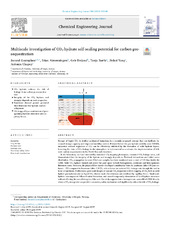| dc.contributor.author | Gauteplass, Jarand | |
| dc.contributor.author | Almenningen, Stian | |
| dc.contributor.author | Ersland, Geir | |
| dc.contributor.author | Barth, Tanja | |
| dc.contributor.author | Yang, Jinhai | |
| dc.contributor.author | Chapoy, Antonin | |
| dc.date.accessioned | 2020-03-18T11:11:23Z | |
| dc.date.available | 2020-03-18T11:11:23Z | |
| dc.date.issued | 2020 | |
| dc.Published | Gauteplass J, Almenningen S, Ersland G, Barth T, Yang, Chapoy A. Multiscale investigation of CO2 hydrate self-sealing potential for carbon geo-sequestration. Chemical Engineering Journal. 2019;381:122646 | eng |
| dc.identifier.issn | 1385-8947 | en_US |
| dc.identifier.issn | 1873-3212 | en_US |
| dc.identifier.uri | https://hdl.handle.net/1956/21521 | |
| dc.description.abstract | Storage of liquid CO2 in shallow geological formations is a recently proposed concept that can facilitate increased storage capacity and improved mobility control. If stored below the gas hydrate stability zone (GHSZ), unwanted vertical migration of CO2 can be effectively inhibited by the formation of solid hydrate layers. Lowering the risks of CO2 leakage to the atmosphere is instrumental to accelerate the implementation of full-scale carbon sequestration in the North Sea and elsewhere. In the laboratory, we have successfully visualized CO2 trapping phenomena, measured CO2 leakage rates, and demonstrated that the integrity of the hydrate seal strongly depends on fluid-rock interactions and initial water distribution. CO2 propagation in water-filled core samples has been monitored over a total of 140 days inside the GHSZ. Solid CO2 hydrate formed and sealed the pore space in both homogeneous sandstone and heterogeneous limestone cores. However, the physical flow barrier developed considerably faster in sandstone (after 1.8 pore volumes – PV) compared to limestone (after 7.4 PV), with a factor ten reduced CO2 leakage rate through the seal in favor of sandstone. Furthermore, pore-scale images of upward CO2 migration verified trapping of CO2 both as solid hydrate precipitation and as liquid CO2 clusters made discontinuous and stabilized by capillary forces. Small-scale hydrate rearrangement followed initial formation, and caused temporarily dissociation of local hydrate structures without affecting the overall integrity of the seal. Our study suggests that a homogeneous, water-filled GHSZ directly above a CO2 storage site can provide a secondary safety mechanism and significantly reduce the risk of CO2 leakage. | en_US |
| dc.language.iso | eng | eng |
| dc.publisher | Elsevier | en_US |
| dc.rights | Attribution CC BY-NC-ND | eng |
| dc.rights.uri | http://creativecommons.org/licenses/by-nc-nd/4.0/ | eng |
| dc.title | Multiscale investigation of CO2 hydrate self-sealing potential for carbon geo-sequestration | en_US |
| dc.type | Peer reviewed | |
| dc.type | Journal article | |
| dc.date.updated | 2020-01-24T09:00:57Z | |
| dc.description.version | publishedVersion | en_US |
| dc.rights.holder | Copyright 2019 The Author(s) | en_US |
| dc.identifier.doi | https://doi.org/10.1016/j.cej.2019.122646 | |
| dc.identifier.cristin | 1722935 | |
| dc.source.journal | Chemical Engineering Journal | |
| dc.relation.project | Norges forskningsråd: 255490 | |

